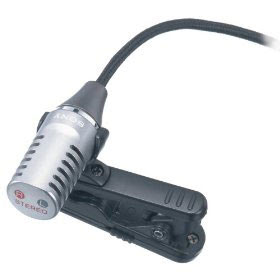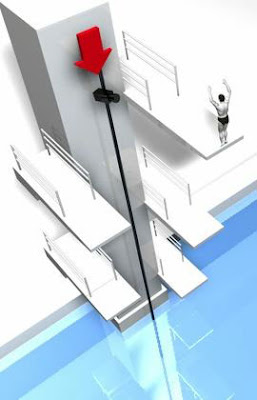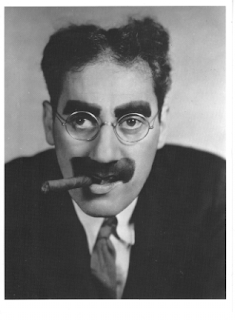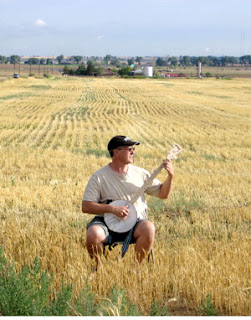Source: xkcd: http://xkcd.com/461/]
Tidbits I think might be interesting to technology teachers and the tech curious.
Friday, August 29, 2008
Thursday, August 28, 2008
Prosthetic Arm Update
Wednesday, August 27, 2008
Hiding a Lav Mic

My students don't like to use the lav mics when videotaping. The main reason given to me is that they don't like how they look with that ugly "black thing" hanging on their clothing. The second reason is they don't want to take the time to set up a secondary mic. In regards to taking the time, I can usually win them over after they have had to re-shoot footage several times because of bad sound. In regards to the first reason, I am going to show them this video from Videomaker that describes several ways of hiding a mic. I like the clever idea of hiding a lav mic inside a pen that then sticks up out of your pocket. I am also going to be adding some medical tape (attaching mic to skin) and some moleskin (lessens the effect of cloth rubbing against mic) to our video tool kit.
[Image: "Sony ECM-CS10 Tie-Clip-Style Omnidirectional Business Microphone": Captured from Amazon.com: http://www.amazon.com/Sony-ECM-CS10-Tie-Clip-Style-Omnidirectional-Microphone/dp/B000246SKU/ref=tag_tdp_sv_edpp_i]
Tuesday, August 26, 2008
DiveCam

Here is a Wall Street Journal article, Now Diving: Sir Isaac Newton, describing the camera setup used to film the divers at the Olympics. Basically, they drop the camera at the same time the diver jumps and the two fall at the same speed.
"When you stand up there," he says, "it makes you marvel at what these athletes will do. We were thinking: What must it be like to plummet from that height? How can we capture the sensation?"
The falling camera rides a rail on the inside of the pipe. A glass strip runs along the pipe's full length; the camera takes its picture through the glass. From the diving platform to the water line, the glass is smoky. Below the line, it's clear, so the camera need not adjust its exposure as it streaks into underwater darkness.
They have a little flash movie demoing how the camera moves here.
[Image: Captured from "Beijing's Diving Eye": http://online.wsj.com/public/resources/documents/info-flash08.html?project=DIVECAM08]
Monday, August 25, 2008
Ergonomic School Furniture
 I once asked a class of eighth graders to re-design a school classroom. Cost was no limit. What I got was essentially 25 different versions of a home entertainment center. If I wanted to kick back and watch a movie and have a snack, I could have found the perfect design. A place to learn...not so much.
I once asked a class of eighth graders to re-design a school classroom. Cost was no limit. What I got was essentially 25 different versions of a home entertainment center. If I wanted to kick back and watch a movie and have a snack, I could have found the perfect design. A place to learn...not so much.This site for an ergonomically designed elementary school desk got me to thinking about that project again and how I might do it now. I made a couple of mistakes with my lesson plan. First, we should have spent some time defining the purpose of a classroom. How is it used? What is essential? Identify the things they didn't like about their own classrooms.
Second, I started too broad. I should have had students think about various components of the classroom first before I asked them for a complete plan. Sometimes it's helpful to start with the big picture and then move down to the components. In this case, I wish I had started with some of the details and then worked up.
[Image: Captured from website: Perch: http://www.perch.ie/]
Friday, August 22, 2008
Thursday, August 21, 2008
Most Important Factor in the Classroom

David Warlick's was recently blogging about Doug Johnston, an educator from Minnesota. David was pulling quotes from a presentation Johnston was giving at a leadership conference . Some of the statements peaked my interest and I googled my way over to Johnston's website where I spent some time reading and exploring. He has a page called My Biases where he lists his beliefs about education, technology and several other topics. I enjoyed reading them and was inspired to load up my own word processor and start my own list. I'll share one of mine.
The single most important factor in any classroom is the teacher.This is a humbling and an empowering belief on my part. It is also handy to chant when you are short on supplies, desks or half your computers have crashed.
[Image: "Teaching": Flickr: July 25, 2007 by jmurawski:http://www.flickr.com/photos/jmurawski/902479272/: Modified with cheesy special effects by Al Gunn ]
Wednesday, August 20, 2008
How to Innovate Without Extra Money

Today is my first day back with students. It's the real start to the school year. The first few weeks can sometimes be overwhelming when you start thinking about all the hurdles and expectations. I've seen many a young teacher with sweaty brow and shaking hands stumbling through the hall ways during the first week mumbling, "It's too much. It's too much."
My advice: Relax and look for the good things. It is so easy to get caught up with the problems, the lack of resources, and bad coffee. You'll do fine.
In that vein, I thought I'd share a positive article from Edutopia.com called "Overcoming Technology Barriers: How to Innovate Without Extra Money or Support" It's written with the struggling teacher in mind, giving him or her some advice on how to start using technology in their classrooms now. Don't wait for your state or district to come through with those funds, all you need to be innovative is you. Here are the main points:
- Innovate with the Tools You Already Have
- Seek Out Free, Easy-to-Use Digital Resources
- Overcome Your Fear of the Unknown
- Start with Small, Fast Projects That Enhance Learning
- Learn with Your Students
Of course, teachers don't need to wait for districts to create formal opportunities for professional growth. "Find someone to learn with, a study group or buddy in your own building or in another school," Conery says. "Take a unit you love and talk about how you can infuse technology to enhance learning and go even deeper."
It's not about the stuff," Carleton emphasizes. "It's about making connections and working with what you already have.
[Image: "No money in Switzerland": Flickr: Uploaded on November 12, 2006 by pug freak: http://www.flickr.com/photos/pugfreak/295278828/]
Tuesday, August 19, 2008
Editing to Music
 One last idea from the Videomaker Conference I recently attended. This technique was discussed in a session on Editing the first day and then we got a chance to try it out during the Premiere workshop the following day.
One last idea from the Videomaker Conference I recently attended. This technique was discussed in a session on Editing the first day and then we got a chance to try it out during the Premiere workshop the following day.Most folks who edit have edited something to match the beat of a song. Determine the count of the music and then time your cuts to that rhythm. I teach this to my students usually in reference to creating a music video. What the conference showed me is that you can use a music selection to create the rhythm of your video but it does not have to be the music you use in your final production.
I didn't really see how this might work until I tried it. I cut a short piece to match the beat on "Moonlight Sonata". Then I experimented with changing the background music. Some songs were a faster tempo. Some slower. Some about the same. It didn't seem to matter. The edited video flowed nicely with any of the selections. Even when the cuts didn't fall on any particular beat, the two tempos just seemed to meld. Fascinating.
The presenters did warn us that if the tempo changed drastically it might not fit. (But even then, sometimes it does.) I'm excited to try this out with my students.
[Image: "Feel Music": Flickr: Uploaded on May 5, 2006 by XŤЯΣΛМ i: http://www.flickr.com/photos/xtream_i/140875083/]
Monday, August 18, 2008
Record some Ambient Noise

Another useful idea I got from the Videomaker conference.
When filming on location record 30-60 seconds of the ambient noise. If it's a room full of people, have them sit quietly for that time period. This little bit of static noise is great for when you have a sound glitch in the editing room and have to cut it out. If you leave that sound hole it will be noticeable when you play it back as even the quietest location has some kind of ambient noise.
In the past, I have cut out bits of quiet background from other parts of the video to cover this kind of glitch. Having this band aid bit of background noise makes so much more sense. I'll be adding this to the list of things my students need to do when they are filming on location.
[Original Image: Flickr: "Listening during a TA development Session": Uploaded on July 11, 2008 by k. erickson: http://www.flickr.com/photos/iskr/2658978480/: Modified by Al Gunn]
Saturday, August 16, 2008
What if the U.S. won no Olympic medals?

Interesting thought from The Two Million Minute Blog regarding the Olympics.
What if the U.S. won no gold, no silver and no bronze medals? Even worse, what if the U.S. team finished 25th in the medal competition – way behind both smaller and larger countries? Would we handle it with the same nonchalance we have about our children ranking 25th in the world in mathematics? Would it merit a Blue Ribbon panel whose recommendations are never implemented? Would it generate a brief mention in the news and then pass from our minds?Hmmmmm? I don't think we would take it very well.
[Image: "Raising the Olympic Flag": Uploaded on February 28, 2006 by Tzatziki: http://www.flickr.com/photos/wing-mui/105967616/]
Friday, August 15, 2008
Funny: Committee of Clocks
Thursday, August 14, 2008
Light Source

Handy rule of thumb I got from the Videomaker Conference last week.
"The bigger your light source the softer the shadow.
The smaller your light source the harder the shadow."
This helps explain why a light diffuser softens the shadows on your talent. It's bigger so the shadows are softer. The sun is a small source and will give you a hard shadow. Clouds will diffuse the sun's light making it a bigger source which then softens the shadows.
This is one of those handy references that kids (and their doddering old teacher) can remember when lighting a shoot. I'm not enough of an expert to know if this holds true 100% of the time (and I neglected to ask this question) but it worked with every example they showed us.
[Image: "Sun sets for the last time in 2008": Flickr: Uploaded on March 2, 2006 by Pandiyan: http://www.flickr.com/photos/pandiyan/106707806/]
Wednesday, August 13, 2008
The Groucho Walk

Another little tid-bit I picked up at the Videomaker conference last week.
If you need to walk and film at the same time and don't have access to a truck or any kind of stabilizer. Walk like Groucho Marx. The exaggerated walk helps steady the shot.
I looked for an example of this on the web for you folks who are too young to remember a Marx Brothers film. No luck. I did find a few references to this style of walking for people in law enforcement or the military who are shooting a gun. It does the same thing....keeps your upper body stable.
Essentially, keep your knees bent and your torso a little lower to the ground. Then walk. It looks weird but it works. I've included another tutorial from Videomaker today describing some other techniques for keeping your camera steady.
While searching for the Groucho Walk, I did spend a lot of time reading about Groucho Marx and watching some clips of his movies. It was a fun search. I'll leave you with a few quotes:
“One morning I shot an elephant in my pajamas. How he got into my pajamas I'll never know.”
“If you've heard this story before, don't stop me, because I'd like to hear it again.”
“I was going to thrash them within an inch of their lives, but I didn't have a tape measure”
“If I held you any closer I would be on the other side of you.”
“I find television very educating. Every time somebody turns on the set, I go into the other room and read a book.”
[Image captured at http://www.fredonia.edu/department/english/shokoff/Filmhome.htm]
[Quotes gathered from ThinkExist.com: http://thinkexist.com/quotes/Groucho_Marx/]
Tuesday, August 12, 2008
Lonely banjo player looking for other pickers. No long term commitment!

Have you ever been sitting in the backyard with the banjo on one knee and a fresh mohito on the other frailing a lonely song because all your picking buddies are out of town or they have a job? A job that doesn't allow for mohitos in the middle of the day let alone any banjo picking.
Or, maybe it's the middle of the night and it's humid and the sheets are clammy and you just had that dream. You know, the one about a mountain sized lizard with sub-prime teeth and budget-cut eyes chasing you through the school's hallways and all you have on is a pair of underwear. That embarrassing pair hidden in the back of your sock drawer because they're bikini briefs, pure silk and have "hot papa" stenciled in pink right across the fanny. And, and in your dream, all the children are laughing and screaming "Run hot poppa, run." while your principal is standing there saying, "Can't you control your classroom Mr. Gunn?"
That dream.
It wakes you up and drives you out of bed to the refrigerator looking for pickles and salami. On the way to the ice box, you grab the banjo with the idea of playing the night heebi-jeebies away and wish that you had a picking buddy to play with you there in your dark kitchen. But your picking buddies all frown on being called in the middle of the night to come over and play. Their wives already disapprove of you because of your mohito habit.
What's a picker to do?
Go to Mando Jam! This website comes out of Maine where the proprietor, Adam, records songs and lists the chord progressions of each song. You can pick along. It lets you play with someone else anytime you want.
Patrick Costello over at Tangier Sound pointed his readers to this site. If you have the time, visit his blog and take a look at the new line of banjos he and his "Dear Old Dad" are creating. He demoed the Somerset S-2 recently. Impressive.
[Image: "Al in a field": Feel free to use this picture if you ever need a shot of a man sitting in a field playing a banjo.]
Monday, August 11, 2008
Three Point Lighting

I mentioned learning about Three Point Lighting at the Videomaker Conference I attended. While looking through some of the Videomaker tutorials, I ran across this one that demos the process. While videos and diagrams are helpful, I still found watching someone do this in the flesh to be an invaluable experience. If you ever get a chance, have a knowledgeable person demonstrate the set up and describe what each of the three lights are supposed to do.
The three articles Mark mentions at the end of the video are bookmarked here for your, and my, easy reference.
Illuminations: Why Three-Point Lighting?
Illuminations: Applying 3-Point Lighting
Light Source: Lighting Women/Lighting Men
[Image: "I know I'll never have to turn that light on again": Flickr: Uploaded on January 24, 2006 by eqqman: http://www.flickr.com/photos/eqqman/90571238/]
Friday, August 8, 2008
Thursday, August 7, 2008
VideoMaker Conference

I spent this past weekend at a VideoMaker Conference held in the Denver area. The first day, The Basics of Video Production, was divided up into four sections: Camcorder Overview, Choosing the Right Microphones, Editing Techniques and Lighting Techniques. Mark Montgomery, Technical Editor for Videomaker was the presenter for each session except Editing Techniques which was given by Boyd McCollum, a documentary film editor. I took something valuable away from each session. (How often can you say that about a conference you've attended?) My only complaint is that it was a lot of information for two days. I'd prefer a more hands on approach but if you are looking to get a lot of information in a hurry, this might be the workshop for you.
My favorite session on the first day was Lighting Techniques. There was a general discussion of lighting and equipment, including some inexpensive alternatives. The best part though was lighting up a volunteer using a three-point setup. I've done this before following diagrams from a book on lighting. I always felt like I was stumbling around in the dark. (My students usually groan after a comment like that.....feel free to groan in the privacy of your own home.) Seeing how Mark adjusted each of the three light sources based on the room made it all click. I think I finally get it.
The second day was a hands-on workshop using Adobe Premiere. I've been using Premiere for a couple of years and I am proficient enough to put together a video. I am pretty much self-taught from books and videos. What I discovered from this workshop is that I've been doing many tasks the hard way. If you are an advanced user, this would probably not have been as valuable to you. If you are a rank beginner, this might have seemed overwhelming, although there were a couple of beginners in the group and they were able to keep up. If you are like me (advanced-beginner?) this workshop might prove valuable to you. Of course, it is only a one day workshop and Premiere is a huge program so don't plan on becoming an expert from one day of instruction.
I would recommend the VideoMaker workshops to anybody at a beginning or intermediate skill level. If you are a teacher looking for college credit or continuing-ed credit be aware that the conference isn't accredited (at least for Colorado). I got it approved by my district ahead of time. That will make my district happy and help me eventually reach a pay raise. That will make me happy.
Check out the Videomaker conferences. They travel to various cities throughout the year.
[Image: "Videomaker Logo": Captured from Videomaker Home Page: http://www.videomaker.com/: Aug 2008]
Sunday, August 3, 2008
Google's advice to students

The Google Blog recently had a post about what they are looking for in an applicant's educational background. Their answer to "What are we looking for?"
At the highest level, they are looking for non-routine problem-solving abilities.They want people with the following skills: analytical reasoning, communication skills, a willingness to experiment, team players, passion and leadership.
Their advice for what a student should take in school is:
It's easy to educate for the routine, and hard to educate for the novel. Keep in mind that many required skills will change: developers today code in something called Python, but when I was in school C was all the rage. The need for reasoning, though, remains constant, so we believe in taking the most challenging courses in core disciplines: math, sciences, humanities.Point your students to this page when they ask what classes they should take. (Maybe your school counselors too.)
And then keep on challenging yourself, because learning doesn't end with graduation.
[Image: Flickr: "365:Prarie Dog":Uploaded on April 9, 2007 by Speshul Ted: http://www.flickr.com/photos/speshulted/452968691/: Creative Commons]
Friday, August 1, 2008
Subscribe to:
Posts (Atom)

